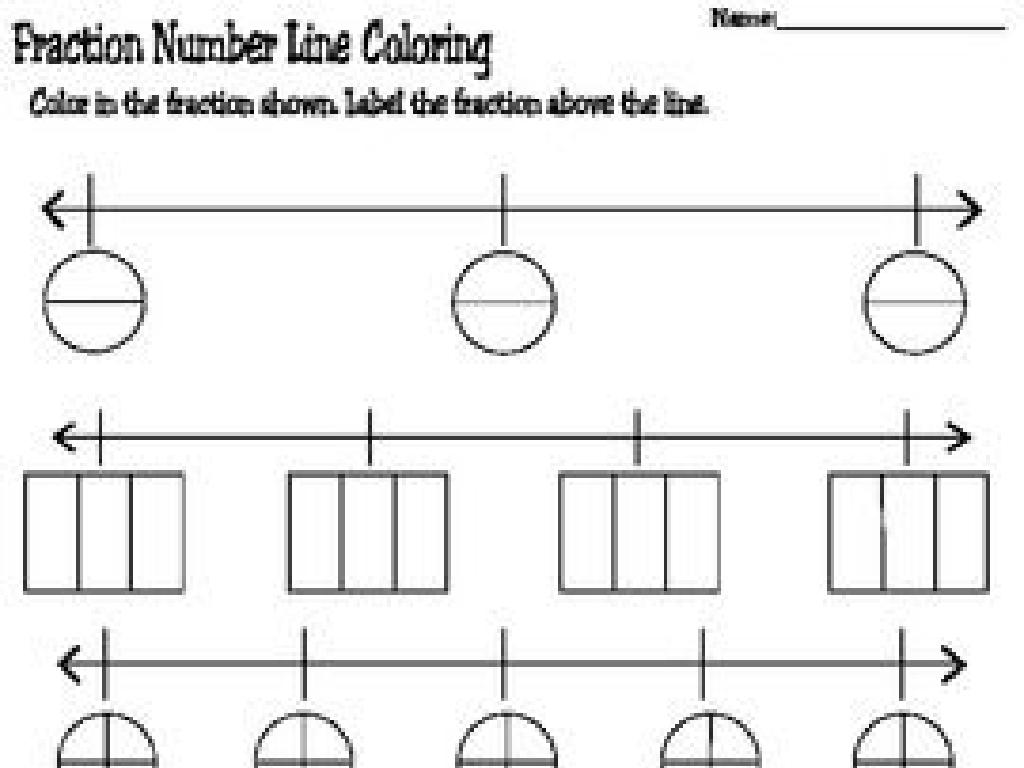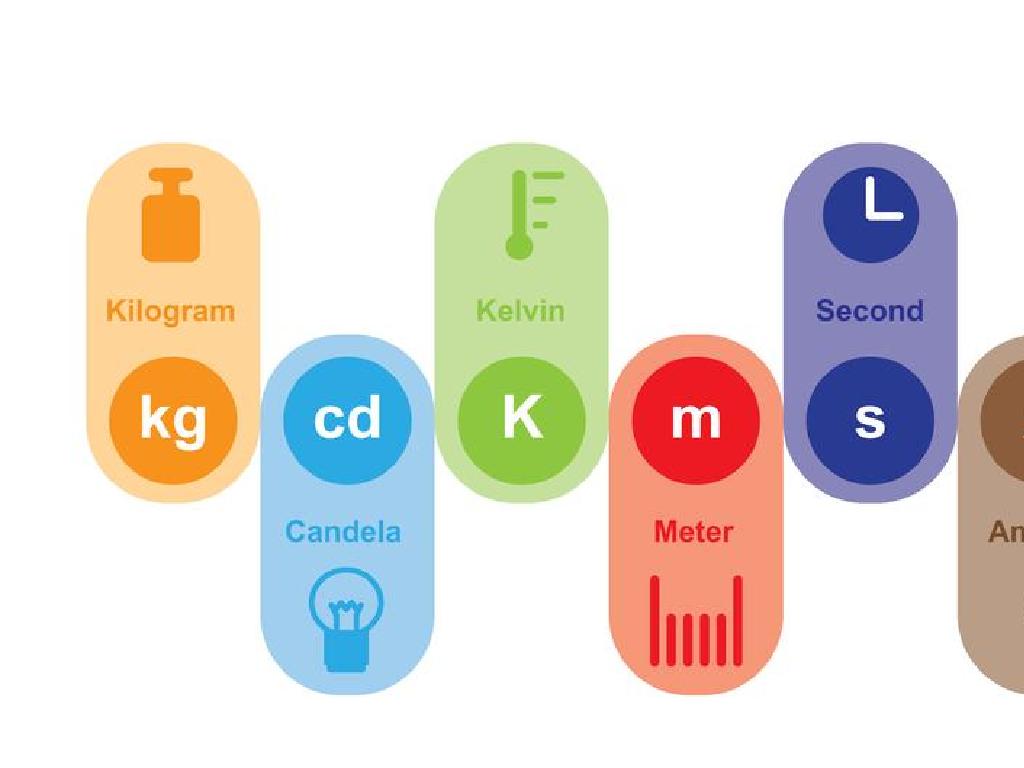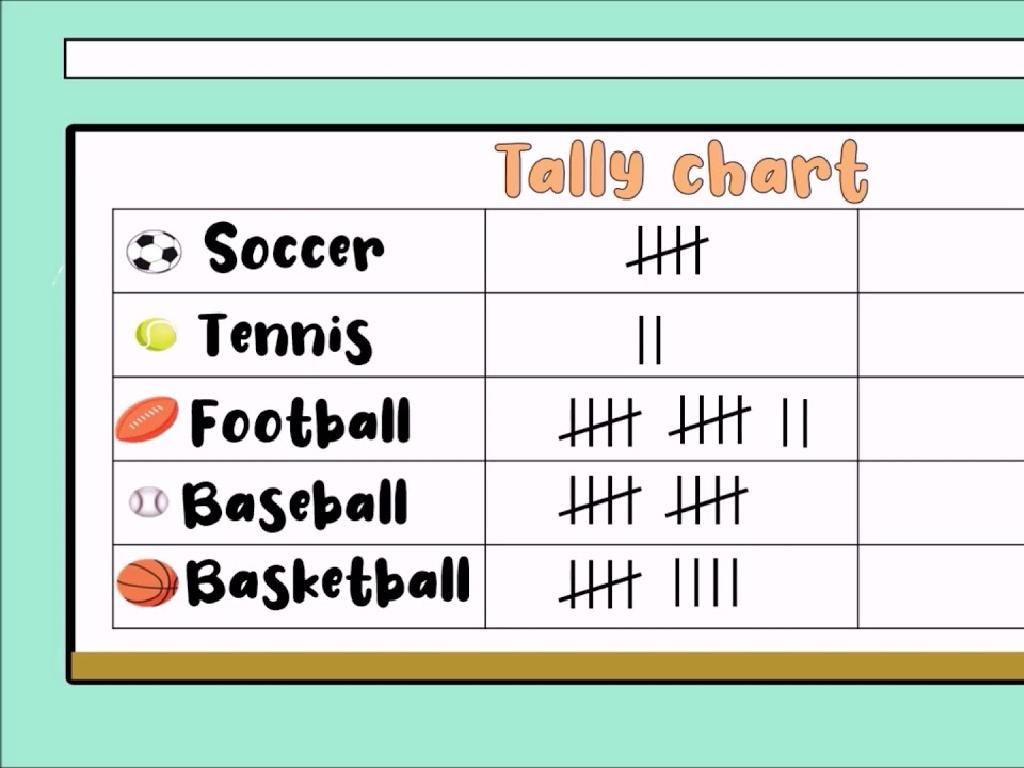Graph Fractions Equivalent To 1 On Number Lines
Subject: Math
Grade: Third grade
Topic: Fractions Equivalent To Whole Numbers
Please LOG IN to download the presentation. Access is available to registered users only.
View More Content
Welcome to Fractions: Whole Number Equivalents
– Special fractions equal to whole numbers
– Fractions like 4/4 or 7/7 equal 1 whole
– Understanding equivalent fractions
– Equivalent fractions have the same value
– Quick review: What is a fraction?
– A fraction shows parts of a whole
– Exploring fractions on a number line
– We’ll draw fractions to see they equal 1
|
This slide introduces third graders to the concept of fractions that are equivalent to whole numbers, specifically the number 1. Begin by explaining that some fractions, where the numerator and denominator are the same, are equal to one whole. Clarify the concept of equivalent fractions by showing that different fractions can represent the same value. Review the basic definition of a fraction as a part of a whole, using visual aids like pie charts or pizza slices. Finally, demonstrate how to graph these special fractions on a number line, emphasizing that when the spaces between 0 and 1 are divided equally, and all are filled, it represents a whole. Use interactive activities on the number line to reinforce the concept.
Understanding Fractions
– A fraction shows part of a whole
– Like a slice of pizza is part of a whole pizza
– Top number is the numerator
– It tells us the count of parts we’re considering
– Bottom number is the denominator
– It shows into how many total slices the pizza is cut
– Numerator: parts we have
– If we have 2 slices and there are 2 in total, that’s 2/2 or a whole
|
This slide introduces the concept of fractions to third-grade students by relating it to something familiar, like slices of pizza. Explain that the numerator (top number) indicates how many slices of the pizza they have, while the denominator (bottom number) shows the total number of slices the pizza was cut into. Emphasize that when the numerator and denominator are the same, it means they have a whole pizza, which is equivalent to 1. Use visual aids like pictures of pizzas with different numbers of slices to help students visualize the concept. Encourage students to think of other examples of fractions in their daily lives.
Whole Numbers as Fractions
– Fractions can equal whole numbers
– Numerator = Denominator means 1
– If the top and bottom numbers are the same, it’s like having 1 whole pizza
– Examples: 3/3, 5/5, 8/8
– These are all different ways to write 1
– All these fractions are equal to 1
– Imagine dividing a cookie into 8 pieces and having all 8, that’s 1 whole cookie!
|
This slide introduces the concept that fractions can represent whole numbers, specifically the number 1. Emphasize that when the numerator (the top number) and the denominator (the bottom number) of a fraction are the same, the value is equal to 1. Use relatable examples like a whole pizza or a cookie to illustrate this point. Encourage students to think of other examples where they have something divided into equal parts, and they have all the parts. This will help them understand that having all parts of something means they have a whole of that thing. This concept is foundational for understanding how to graph fractions equivalent to 1 on a number line.
Number Lines and Fractions
– Number lines show numbers and fractions
– A straight line with equal intervals
– Mark whole numbers on the line
– Numbers like 0, 1, 2, 3 are whole numbers
– Fractions can be placed too
– Fractions like 1/2 or 3/4 show parts of a whole
|
This slide introduces the concept of number lines as a visual tool to help students understand the placement of numbers and fractions. Emphasize that a number line is a straight path where numbers are spaced at regular intervals. Show that whole numbers are easy to find as they are the main markers on the line. Then, explain that fractions represent parts of a whole and can also be located on the number line. For example, the fraction equivalent to 1, such as 4/4 or 5/5, is at the same point as the whole number 1. Use simple fractions that are equivalent to 1 to illustrate this concept. Encourage students to draw their own number lines and practice placing both whole numbers and fractions on them.
Graphing Fractions Equivalent to 1
– Number lines show fractions
– Fractions like 1 are at number 1
– Graphing 1/2, 2/2, 3/3 examples
– 1/2 is halfway, 2/2 is at 1, 3/3 also at 1
– Practice graphing with different fractions
– Try graphing 4/4 or 5/5 on your own
|
This slide introduces students to the concept of graphing fractions on a number line, emphasizing that each point can represent a fraction. It’s crucial to highlight that fractions equivalent to 1 are always graphed at the number 1 on the line. Use examples like 1/2, 2/2, and 3/3 to show how fractions are placed on the number line, with 2/2 and 3/3 being equivalent to 1. Encourage students to practice by graphing other fractions equivalent to 1, such as 4/4 or 5/5, to reinforce the concept. Provide hands-on activities where students can draw their own number lines and graph given fractions to solidify their understanding.
Graphing Fractions Equivalent to 1
– Equivalent fractions equal the same
– Examples: 2/2, 4/4, 6/6
– Like pieces of a whole pie
– All these fractions equal 1
– They look different but are the same as a whole
– Let’s graph on a number line
– See how they all point to ‘1’ on the line
|
This slide introduces the concept of equivalent fractions and their representation on a number line. Start by explaining that even though fractions like 2/2, 4/4, and 6/6 may look different, they all represent the same value, which is ‘1 whole’. Use visual aids like pie charts to show how these fractions make up a whole. Then, demonstrate how to graph these fractions on a number line, emphasizing that each of these fractions will point to the same place, the number ‘1’. This will help students visually understand that these fractions, despite having different numerators and denominators, are equivalent to one whole. Encourage students to draw their own number lines and practice graphing different equivalent fractions.
Practice Time: Graphing Fractions
– Graph fractions equal to 1
– Use your number line worksheet
– Find the worksheet with the number lines
– Graph 5/5, 7/7, 10/10
– Place a point on the number line where the fraction pieces add up to 1
– Remember, they all equal 1 whole!
|
This slide is designed for a hands-on activity where students will apply their knowledge of fractions equivalent to whole numbers by graphing them on a number line. Provide each student with a worksheet that has several number lines. Guide them to graph 5/5, 7/7, and 10/10, emphasizing that these fractions are all equal to one whole unit. This activity reinforces the concept that a fraction with the same numerator and denominator is equal to 1. Encourage students to check their understanding by verifying that the point they marked on the number line aligns with the whole number 1. Offer assistance as needed and prepare to discuss the activity in the following class, addressing any questions or misconceptions.
Class Activity: Fraction Number Line Race
– Pair up for a graphing race
– Graph fractions equal to 1
– Fractions like 1/1, 2/2, 3/3 all equal 1
– First to finish correctly wins
– Ready, set, graph!
|
This activity is designed to be a fun and interactive way for students to practice graphing fractions equivalent to 1 on a number line. Before starting, ensure that each pair has a number line and different colored markers. Review what it means for fractions to be equivalent to 1, using examples like 1/1, 2/2, 3/3, etc. Explain that each pair will receive a set of fraction cards, and they must graph each fraction on a number line as quickly and accurately as possible. The first pair to finish with all fractions correctly placed wins a small prize. This will help reinforce the concept of equivalent fractions and how they are represented on a number line. After the activity, discuss any common mistakes and clarify misunderstandings. Possible variations of the activity could include using fractions that are not equivalent to 1, timing each pair to create a sense of urgency, or having a relay race where students take turns graphing one fraction at a time.
Mastering Fractions on Number Lines
– Congratulations on your hard work!
– Fractions with equal top and bottom numbers are 1
– Like 3/3, 4/4, or 5/5, they all equal 1
– Practice makes perfect with fractions
– Try different fractions to see how they line up
– You’re on your way to becoming fraction experts!
|
This slide is a conclusion to reinforce the students’ understanding of graphing fractions equivalent to 1 on number lines. Emphasize the concept that fractions with the same numerator and denominator always equal 1. Encourage the students to continue practicing with different fractions to strengthen their skills. Acknowledge their efforts and progress to boost their confidence. As a follow-up activity, you can have students create their own number lines with fractions equivalent to 1 and share them with the class or take home to teach their families.






